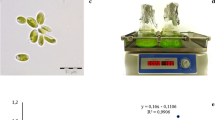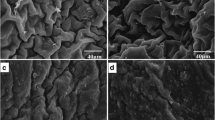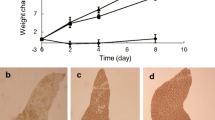Abstract
Ultra Performance Liquid Chromatography-Electrospray ionization-Quadrupole-Time of Flight Mass Spectrometry (UPLC-ESI-Q-TOF–MS) is a powerful lipidomic tool. In this study, we developed a UPLC/Q-TOF–MS based method to investigate the lipid metabolomic changes in different growth phases of Nitzschia closterium f. minutissima. The data classification and biomarker selection were carried out by using multivariate statistical analysis, including principal components analysis (PCA), projection to latent structures with discriminant analysis (PLS-DA), and orthogonal projection to latent structures with discriminant analysis (OPLS-DA). We discovered that the intercellular lipid metabolites were significantly different among exponential, early stationary and late stationary phases. Thirty-one lipid molecules were selected and identified as putative biomarkers, including free fatty acid, Harderoporphyrin, phosphatidylglycerol, 1,2-diacyglycerl-3-O-4′-(N,N-trimethy)-homoserine, triacylglycerol, cholesterol, sulfoquinovosyldiacylglycerol, lyso-sulfoquinovosyldiacylglycerol, monogalactosyldiacylglycerol, digalactosyldiacylglycerol and lyso-digalactosyldiacylglycerol. These lipids have been shown previously to function in energy storage, membrane stability and photosynthesis efficiency during the growth of diatoms. Further analysis on the putative biomarkers demonstrated that nitrate starvation played critical role in the transition from exponential phase to stationary phase in N. closterium. This study is the first one to explore the lipidomic changes of microalgae in different growth phases, which promotes better understanding of their physiology and ecology.





Similar content being viewed by others
Abbreviations
- UPLC:
-
Ultra-performance liquid chromatography
- Q-TOF-MS:
-
Quadrupole time-of-flight mass spectrometry
- MS/MS:
-
Tandem mass spectrometry
- TIC:
-
Total ion current chromatogram
- ESI:
-
Electrospray ionization
- PCA:
-
Principal components analysis
- PLS-DA:
-
Projections to latent structures discriminant analysis
- OPLS-DA:
-
Orthogonal projections to latent structures discriminant analysis
- PG:
-
Phosphatidylglycerol
- FA:
-
Fatty acid
- FFA:
-
Free fatty acid
- TAG:
-
Triacylglycerol
- SQDG:
-
Sulfoquinovosyldiacylglycerol
- lyso-SQDG:
-
Lysosulfoquinovosyldiacylglycerol
- MGDG:
-
Monogalactosyldiacylglycerol
- DGDG:
-
Digalactosyldiacylglycerol
- lyso-DGDG:
-
Lyso digalactosyldiacylglycerol
- DGTS:
-
1, 2-diacyglycerl-3-O-4′-(N,N-trimethy)-homoserine
- PUFA:
-
Polyunsaturated fatty acid
- SFA:
-
Saturated fatty acid
- MUFA:
-
Monounsaturated fatty acid
References
Bligh, E. G., & Dyer, W. J. (1959). A rapid method of total lipid extraction and purification. Canadian Journal of Biochemistry and Physiology, 37(8), 911–917.
Brown, M. R., Dunstan, G, A., Norwood, S.J., & Miller K.A. (1996). Effests of harvest stage and light on the biochemical composition of the diatom Thalassiosira pseudonana. Journal of Phycology, 32, 64–73.
Brown, M. R., & Farmer, C. L. (1994). Riboflavin content of six species of microalgae used in mariculture. Journal of Applied Phycology, 6, 61–65.
Brügger, B., Erben, G., Sandhoff, R., Wieland, F. T., & Lehmann, W. D. (1997). Quantitative analysis of biological membrane lipids at the low picomole level by nano-electrospray ionization tandem mass spectrometry. Proceedings of the National academy of Sciences of the United States of America, 94, 2339–2344.
De Pauw, N. M., Morales, J., & Persoone, G. (1984). Mass culture of microalgae in aquaculture systems: Progress and constraints. Hydorobiologia, 116, 121–134.
Farag, M. A., Porzel, A., Schmidt, J., & Wessjohann, L. A. (2011). Metabolite profiling and fingerprinting commercial cultivars of Humulus lupulus L. (hop): comparison of MS and NMR methods in metabolomics. Available: http://www.springerlink.com/content/356355214x808628/.
Fidalgo, J. P., Cid, A., Torres, E., Sukenik, A., & Herrero, C. (1998). Effects of nitrogen source and growth phase on proximate biochemical composition, lipid classes and fatty acid profile of the marine microalga Isochysis galbana. Aquaculture, 166, 105–116.
Frentzen, M. (2004). Phosphatidylglycerol and sulfoquinovosyldiacylglycerol: Anionic membrane lipids and phosphate regulation. Current Opinion in Plant Biology, 7, 270–276.
Gallager, S. M., Mann, R., & Sasaki, G. C. (1986). Lipid as an index of growth and viability in three species of bivalve. Aquaculture, 56, 81–103.
Garrido, I. M., Hampel, M., Lubian, L. M., & Blasco, J. (2003). Sediment toxicity tests using benthic marine microalgae Cylindrotheca closterium (Ehremberg) Lewin and Reimann (Bacillariophyceae). Ecotoxicology and Environmental Safety, 54, 290–295.
Goldberg, I. K., & Cohen, Z. (2006). The effect of phosphate starvation on the lipid and fatty acid composition of the fresh water eustigmatophyte Monodus subterraneus. Phytochemistry, 67, 696–701.
Guella, G., Frassanito, R., & Mancini, I. (2003). A new solution for an old problem: the regiochemical distribution of the acyl chains in galactolipids can be established by electrospray ionization tandem mass spectrometry. Rapid Communication in Mass Spectrometry, 17, 1982–1994.
Haigh, W. G., Yoder, T. F., Ericson, L., Pratun, T., & Winget, R. R. (1996). The characterization and cyclic production of a highly unsaturated homoserine lipid in Chlorella minutissima. Biochimica et Biophysica Acta, 1299, 183–190.
Han, X. L., & Gross, R. W. (2003). Global analyses of cellular lipidomes directly from crude extracts of biological samples by ESI mass spectrometry: A bridge to lipidomics. Journal of Lipid Research, 44, 1071–1079.
Harford, A. J., Hogan, A. C., Tsang, J. J., Parry, D. L., Negri, A. P., Adams, M. S., et al. (2011). Effects of alumina refinery wastewater and signature metal constituents at the upper thermal tolerance of: 1. The tropical diatom Nitzschia closterium. Marine Pollution Bulletin, 62, 466–473.
Hölzl, G., & Dörmann, P. (2007). Structure and function of glycoglycerolipids in plants and bacteria. Progress in Lipid Research, 46, 225–243.
Hsu, F. F., & Turk, J. (1999). Structural characterization of triacylglycerols as lithiated adducts by electrospray ionization mass spectrometry using low-energy collisionally activated dissociation on a triple stage quadrupole instrument. American Society for Mass Spectrometry, 1999(10), 587–599.
Huang, J. J. H., & Cheung, P. C. K. (2011). +UVA treatment increases the degree of unsaturation in microalgal fatty acids and total carotenoid content in Nitzschia closterium (Bacillariophyceae) and Isochrysis zhangjiangensis (Chrysophyceae). Food Chemisty, 129, 783–791
Huflejt, M. E., Tremolieres, A., Pineau, B., Lang, J. K., Hatheway, J., & Packer, L. (1990). Changes in membrane lipid composition during saline growth of the fresh water Cyanobacterium synechococcus 6311. Plant Physiology, 94, 1512–1521.
Iglesias, N. N., Pancorbo, A. C., & Rodríguez, L. C. (2009). From lipid analysis towards lipidomics, a new challenge for the analytical chemistry of the 21st century. Part II: analytical lipidomics. Trends in Analytical Chemistry, 28, 393–403.
Jones, M. R. (2007). Lipids in photosynthetic reaction centres: structural roles and functional holes. Progress in Lipid Research, 46, 56–87.
Koven, W. M., Thompson, P. A., & Harrison, P. J. (1989). Lipid and n-3 requirement of Sparus aurata larvae during starvation and feeding. Aquaculture, 79, 185–191.
Leonardos, N., & Ian Lucas, A. N. (2000). The nutritional value of alage grown under different culture conditions for Mytilus edulis L.larvae. Aquaculture, 182, 301–315.
Liang, Y., Mai, K. S., & Sun, S. C. (2002). Effects of harvest stag on the total lipis and fatty acid composition of foure Cylindrotheca strains. Chinese Journal of Oceanology and Limnology, 20, 157–161.
Lu, N., Wei, D., Chen, F., & Yang, S. T. (2012). Lipidomic profiling and discovery of lipid biomarkers in snow alga Chlamydomonas nivalis under salt stress. European Journal of Lipid Science and Technology, 114, 253–265.
Mansour, M. P., Volkman, J. K., & Blackburn, S. I. (2003). Effect of growth phase on the lipid class, fatty acid and sterol composition in the marine dinoflagellate Gymnodinium sp. In batch culture. Phytochemistry, 63, 145–153.
Pancorbo, A. C., Iglesias, N. N., & Rodríguez, L. C. (2009). From lipid analysis towards lipidomics, a new challenge for the analytical chemistry of the 21st century. Part II: Modern lipid analysis. Trends in Analytical Chemistry, 28, 263–278.
Rainville, P. D., Stumpf, C. L., Shockcor, J. P., Plumb, R. S., & Nicholson, J. K. (2007). Novel application of reversed-phase UPLC-oaTOF-MS for lipid analysis in complex biological mixtures: a new tool for lipidomics. Journal of Proteome Research, 6, 552–558.
Renaud, S. M., Zhou, H. C., Parry, D. L., Thinh, L. V., & Woo, K. C. (1995). Effect of temperature on the growth, total lipid content and fatty acid composition of recently isolated tropical microalgae Isochrysis sp., Nitzschia closterium, Nitzschia paleacea, and commercial species Isochrysis sp. (clone T.ISO). Journal of Applied Phycology, 7, 595–602.
Roberts, L. D., McCombie, G., Titman, C. M., & Griffin, J. L. (2008). A matter of fat: An introduction to lipidomic profiling methods. Journal of Chromatography B, 871, 174–181.
Roessler, P. G. (1988). Effects of silicon deficiency on lipid composition and metabolism in the diatom Cyclotella Cryptica. Journal of Phycology, 24, 394–400.
Rousch, J. M., Bingham, S. E., & Sommerfeld, M. R. (2003). Changes in fatty acid profiles of thermo-intolerant and thermo-tolerant marine diatoms during temperature stress. Journal of Experiment Marine Biology and Ecology, 295, 145–156.
Sakural, I., Mizusawa, N., Wada, H., & Sato, N. (2007). Digalactosyldiacylglycerol Is Required for Stabilization of the Oxygen-Evolving Complex in Photosystem II. Plant Physiology, 145, 1361–1370.
Sato, N. (1992). Betaine lipids. The Botanical Magazine, Tokyo, 105, 185–197.
Solovchenko, A. E., Goldberg, I. K., Cohen, S. D., Cohen, Z., & Merzlyak, M. N. (2008). Effects of light intensity and ntrogen starvation on growth, total fatty acids and arachidonic in the green microalga Parietochloris incisa. Journal of Applied Phycology, 20, 245–251.
Stauber, J. L. (1998). Toxicity of chlorate to marine microalgae. Aquatic Toxicology, 41, 213–227.
Suen, Y., Hubbard, R. S., Holzer, G., & Tomabede, T. G. (1987). Total lipis production of the green alga Nannochloropsis sp. Q II under different nitrogen. Journal of Phycol, 26, 463–469.
Sukemik, A., Zmora, O., & Cameli, Y. (1991a). Biochemical quality of marine unicellular algae with special emphasis on lipid composition: Isochrysis galbana. Aquaculture, 97, 61-72
Sukemik, A., Zmora, O., & Cameli, Y. (1991b). Biochemical quality of marine unicellular algae with special emphasis on lipid composition: II Nanmochloropsis sp. Aquaculture, 117, 313–326.
Uriarte, I., Roberts, R., & Farías, A. (2006). The effect of nitrate supplementation on the biochemical composition of benthic diatoms and the growth and survival of post-larval abalone. Aquaculture, 261, 423–429.
Van Mooy, B. A. S., Fredricks, H. F., Pedler, B. E., Dyhrman, S. T., Karl, D. M., Koblížek, M., et al. (2009). Phytoplankton in the ocean use non-phosphorus lipids in response to phosphorus scarcity. Nature, 458, 67–70.
Van Vliet, E., Morath, S., Eskes, C., Linge, J., Rappsilber, J., Honegger, P., et al. (2008). A novel in vitro metabolomics approach for neurotoxicity testing, proof of principle for methyl mercury chloride and caffeine. NeuroToxicology, 29, 1–12.
Vidoudez, C., & Ponert, G. (2011). Comparative metabolomics of the diatom Skeletonema marinoi in different growth phases. Retrieved 2 May, 2011 from http://www.springerlink.com/content/m1j02r35w1833g27/.
Viele, A., Wilhelm, C., Goss, R., Süß, R., & Schiller, J. (2007). The lipid composition of the unicellular green alga Chlamydomonas reinhardtii and the diatom Cyclotella meneghiniana investigated by MALDI-TOF MS and TLC. Chemistry and Physics of Lipids, 150, 143–155.
Wang, X. M. (2004). Lipid signaling. Current Opinion in Plant Biology, 7, 1–8.
Wiklund, S., Johansson, E., Sjösttöm, L., Mellerowicz, E. J., Edlund, U., Shokcor, J. P., et al. (2008). Visualization of GC/TOF-MS-based metobolomics data for identification of biochemically interesting compounds using OPLS class models. Analytical Chemistry, 80, 115–122.
Xu, J. L., Chen, D. Y., Yan, X. J., Chen, J. J., & Zhou, C. X. (2010). Global characterization of the photosynthetic glycerolipids from a marine diatom Stephanodiscus sp. by ultra performance liquid chromatography coupled with electrospray ionization-quadrupole-time of flight mass spectrometry. Analytica Chimica Acta, 663, 60–68.
Xu, J. L., Zhou, H. B., Yan, X. J., Zhou, C. X., Zhu, P., & Ma, B. (2012). Effect of unialgal diets on the composition of fatty acids and sterols in juvenile ark shell Tegillarca granosa Linnaeus. Journal of Agricultural and Food Chemistry, 60, 3973–3980.
Yan, X. J., Xu, J. L., Chen, J. J., Chen, D. Y., Xu, S. L., Luo, Q. J., et al. (2012). Lipidomics focusing on serum polar lipids reveals species dependent stress resistance of fish under tropical storm. Metabolomics, 8, 299–309.
Yu, E. T., Zendejas, F. J., Lane, P. D., Gaucher, S., Simmons, B. A., & Lane, T. W. (2009). Triacylglycerol accumulation and profiling in the model diatoms Thalassiosira pseudonana and Phaedactylum tricornutum (Baccilariophyceae) during strvation. Journal of Applied Phycology, 21, 669–681.
Zehethofer, N., & Pinto, D. M. (2008). Recent development in tandem mass spectrometry for lipidomic analysis. Analytic Chimica Acta, 627, 62–70.
Zhang, Z. Z., Lin, C., Liu, C. Y., Xing, L., Wu, Z. Z., & Sun, F. (2005). Study on patterns and chemical features of NO effect on marine phytoplankton growth. Chemistry and Materials Science, 48, 376–384.
Zhu, C. J., Lee, Y. K., & Chao, T. M. (1997). Effect of temperature and growth phase on lipid and biochemical composition of Isochysis galbana TK1. Journal of Applied Phycology, 9, 451–457.
Acknowledgments
This research was supported by the National Natural Science Foundation of China (31172448), the National Sparking Plan Project of China (2011GA701002), Zhejiang Public Welfare Project, China (2010C32021), Zhejiang Natural Science Foundation, China (Y3100534 and Z3100565), Ningbo Science and Technology Research Projects, China (2011C11003 and 2010C10054), Ningbo Marine Algae Biotechnology Team, China (2011B81007), and partly sponsored by K. C. Wong Magna Fund in Ningbo University.
Author information
Authors and Affiliations
Corresponding author
Electronic supplementary material
Below is the link to the electronic supplementary material.
Rights and permissions
About this article
Cite this article
Su, X., Xu, J., Yan, X. et al. Lipidomic changes during different growth stages of Nitzschia closterium f. minutissima. Metabolomics 9, 300–310 (2013). https://doi.org/10.1007/s11306-012-0445-1
Received:
Accepted:
Published:
Issue Date:
DOI: https://doi.org/10.1007/s11306-012-0445-1




